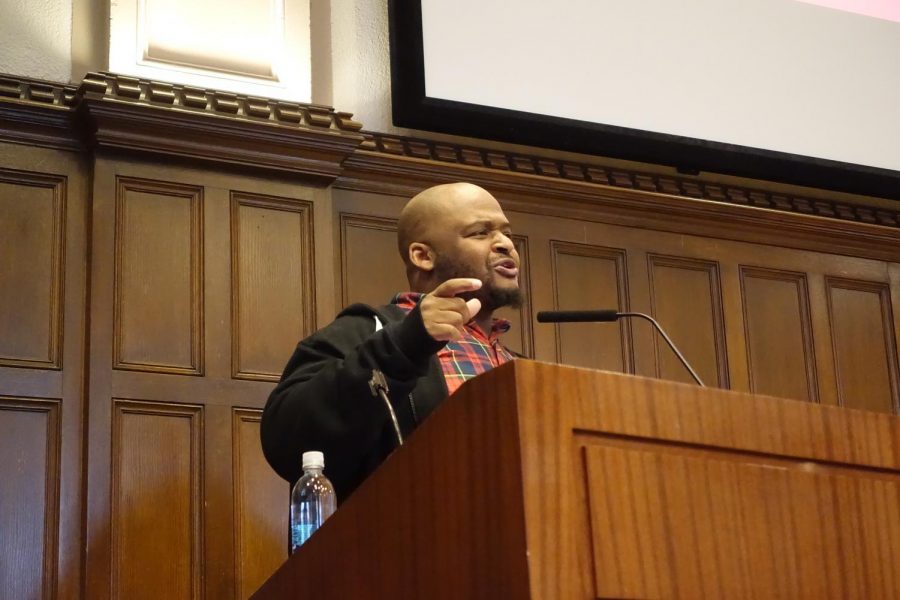Fordham English Department Hosts Author Kiese Laymon
Last Wednesday, April 3, the English Department hosted author Kiese Laymon for its Reid Writers of Color Reading Series in the Keating First auditorium. This event takes place annually to celebrate a prominent writer of color and is made possible by Kenneth and Frances K. Reid. According to the English Department’s webpage, the event was also sponsored by the Fordham English and African & African American Studies departments, the Graduate Student Association and the Creative Writing Program.
Laymon, this year’s writer, is the author of the novel “Long Division” and two memoirs, “How to Slowly Kill Yourself and Others in America” and “Heavy: An American Memoir.” The latter memoir was released last fall and has been named the best book of 2018 by several outlets such as the New York Times, Publishers Weekly, NPR and more, and also received several awards, such as the Andrew Carnegie Medal.
According to Sarah Gambito, director of Creative Writing at Fordham, this year’s reading had been planned for over a year prior to the event, and booking Laymon was facilitated by his friendship with Fordham assistant professor and author Scott Poulson-Bryant.
Gambito and Poulson-Bryant opened the event with introductions. Poulson-Bryant described Laymon’s “Heavy” to the audience as something that found “a way to bridge joy and pain in ways that are new and refreshing … but always intimate in the way that the best literature is.”
Laymon began his reading with gratitude for Gambito and Frances Reid, who was in attendance, as well as humor that made the audience laugh. His reading selection reflected this.
“I usually base what I’m gonna read on what my vibe is,” he said. “I feel very happy right now, so I’m gonna read something that’s gonna make me laugh — whether or not it makes you laugh is up to you.”
He read a chapter titled “Meager,” which detailed his experience with other black children when they attended school with white children for the first time.
“We didn’t feel like this space was ours, so we tried to rhetorically make it ours,” he stated. “And we had to deal with the consequences.”
The reading lasted for about 25 minutes, and because of Laymon’s schedule, there was only time for two questions during the post-reading Q&A.
When asked what it was like to be a person of color while writing “Heavy” and to overcome related obstacles, he said the writing was difficult and referenced his mother, to whom the book is addressed.
“I always wanted to write this book, but I just didn’t have the heart, and I didn’t have the skill,” he said. “And then I just got to a point in my relationship with my mother where I just felt like it was gonna die completely. If it died I felt like we were gonna follow it — literally.”
He expanded upon his choice to address his mother in the second person after the second question.
“I hadn’t seen a memoir really pull off the second person unless used in epistolary form,” he stated. “I didn’t want to write a letter to my mom. … I actually wanted to write a book that put my mama in her black central Mississippi upbringing at the center. So I wanted the space between my mama and me to be the motivating force that kept people turning the pages.”
He cited Christina Sharpe and “The Color Purple” as influences for him throughout the writing process for “Heavy.”
According to Gambito, around 500 students and faculty attended the event. Many of the students were going for their English classes and were able to find the reading a good supplement to the book.
“Hearing his voice read the book definitely makes it so much better,” said Maeve Ambrose, FCLC ’22. “It gives you a better connection.”
Maria Nettgen, FCLC ’22, stated that the reading let her “see the book in a new dimension.”
“Hearing him read it out loud adds a new dynamic to it,” said Meg Whalen, FCRH ’21. “I think I’m gonna download the audiobook actually because when I’m reading it I’m still reading it in my voice … not in his voice, so it’s like hearing a white girl say these words, instead of, like, how they are meant to be said and what he’s actually trying to communicate, so that opened up a new part of this book to me.”
While many focused on what the reading had done for their understanding of the book, Anthony Nunez, FCRH ’22, had unanswered questions for Laymon.
“I have a theory [about] the whole idea of contractions in the book,” he said. “I wish more questions could have been asked.”
Gambito said she could sense the engagement of students.
“It was wonderful to see Fordham students and faculty come out in force for Kiese Laymon,” she said in a statement to the Ram. “The excitement in the air was palpable.”
Copy Chief for Volume 101.







































































































































































































